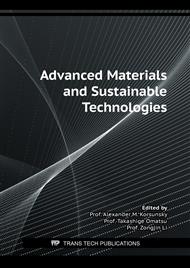[1]
Huang, Z.; Padmaja, K.; Li, S.; Liew, J. Y. R. Mechanical Properties and Microstructure of Ultra-Lightweight Cement Composites with Fly Ash Cenospheres after Exposure to High Temperatures. Constr. Build. Mater. 2018, 164, 760–774.
DOI: 10.1016/j.conbuildmat.2018.01.009
Google Scholar
[2]
Hanif, A.; Lu, Z.; Li, Z. Utilization of Fly Ash Cenosphere as Lightweight Filler in Cement-Based Composites – A Review. Constr. Build. Mater. 2017, 144, 373–384.
DOI: 10.1016/j.conbuildmat.2017.03.188
Google Scholar
[3]
Huang, Z.; Liew, J. Y. R.; Li, W. Evaluation of Compressive Behavior of Ultra-Lightweight Cement Composite after Elevated Temperature Exposure. Constr. Build. Mater. 2017, 148, 579–589.
DOI: 10.1016/j.conbuildmat.2017.04.121
Google Scholar
[4]
Huang, Z.; Liang, T.; Huang, B.; Zhou, Y.; Ye, J. Ultra-Lightweight High Ductility Cement Composite Incorporated with Low PE Fiber and Rubber Powder. Constr. Build. Mater. 2021, 312, 125430.
DOI: 10.1016/j.conbuildmat.2021.125430
Google Scholar
[5]
Yan, J.-B.; Liew, J. Y. R.; Zhang, M.-H.; Li, Z.-X. Punching Shear Resistance of Steel–Concrete–Steel Sandwich Composite Shell Structure. Eng. Struct. 2016, 117, 470–485.
DOI: 10.1016/j.engstruct.2016.03.029
Google Scholar
[6]
Hajimohammadi, A.; Ngo, T.; Provis, J. L.; Kim, T.; Vongsvivut, J. High Strength/Density Ratio in a Syntactic Foam Made from One-Part Mix Geopolymer and Cenospheres. Compos. Part B Eng. 2019, 173, 106908.
DOI: 10.1016/j.compositesb.2019.106908
Google Scholar
[7]
Li, R.; Wu, G.; Jiang, L.; Sun, D. Interface Microstructure and Compressive Behavior of Fly Ash/Phosphate Geopolymer Hollow Sphere Structures. Mater. Des. 1980-2015 2015, 65, 585–590.
DOI: 10.1016/j.matdes.2014.09.063
Google Scholar
[8]
Shao, N.-N.; Liu, Z.; Xu, Y.-Y.; Kong, F.-L.; Wang, D.-M. Fabrication of Hollow Microspheres Filled Fly Ash Geopolymer Composites with Excellent Strength and Low Density. Mater. Lett. 2015, 161, 451–454.
DOI: 10.1016/j.matlet.2015.09.016
Google Scholar
[9]
Wang, M.-R.; Jia, D.-C.; He, P.-G.; Zhou, Y. Microstructural and Mechanical Characterization of Fly Ash Cenosphere/Metakaolin-Based Geopolymeric Composites. Ceram. Int. 2011, 37 (5), 1661–1666.
DOI: 10.1016/j.ceramint.2011.02.010
Google Scholar
[10]
Nawaz, M.; Heitor, A.; Sivakumar, M. Geopolymers in Construction - Recent Developments. Constr. Build. Mater. 2020, 260, 120472.
DOI: 10.1016/j.conbuildmat.2020.120472
Google Scholar
[11]
Fan, L.; Zhang, Z.; Yu, Y.; Li, P.; Cosgrove, T. Effect of Elevated Curing Temperature on Ceramsite Concrete Performance. Constr. Build. Mater. 2017, 153, 423–429.
DOI: 10.1016/j.conbuildmat.2017.07.050
Google Scholar
[12]
Liu, Y.; Shi, C.; Zhang, Z.; Li, N.; Shi, D. Mechanical and Fracture Properties of Ultra-High Performance Geopolymer Concrete: Effects of Steel Fiber and Silica Fume. Cem. Concr. Compos. 2020, 112, 103665.
DOI: 10.1016/j.cemconcomp.2020.103665
Google Scholar
[13]
Farhan, K. Z.; Johari, M. A. M.; Demirboğa, R. Impact of Fiber Reinforcements on Properties of Geopolymer Composites: A Review. J. Build. Eng. 2021, 44, 102628.
DOI: 10.1016/j.jobe.2021.102628
Google Scholar
[14]
RILEM Technical Committee 200-HTC. Recommendation of RILEM TC 200-HTC: Mechanical Concrete Properties at High Temperatures—Modelling and Applications. Mater. Struct. 2007, 40 (9), 855–864.
DOI: 10.1617/s11527-007-9286-1
Google Scholar
[15]
Luo, Y.; Li, S. H.; Klima, K. M.; Brouwers, H. J. H.; Yu, Q. Degradation Mechanism of Hybrid Fly Ash/Slag Based Geopolymers Exposed to Elevated Temperatures. Cem. Concr. Res. 2022, 151, 106649.
DOI: 10.1016/j.cemconres.2021.106649
Google Scholar
[16]
Zhang, H. Y.; Kodur, V.; Qi, S. L.; Cao, L.; Wu, B. Development of Metakaolin–Fly Ash Based Geopolymers for Fire Resistance Applications. Constr. Build. Mater. 2014, 55, 38–45.
DOI: 10.1016/j.conbuildmat.2014.01.040
Google Scholar
[17]
Görhan, G. The Evaluation with Anova of the Effect of Lime Admixture and Thermal Cure Time on Fly Ash Paste Activated with Sodium Silicate Solution. Constr. Build. Mater. 2015, 94, 228–234.
DOI: 10.1016/j.conbuildmat.2015.07.011
Google Scholar



